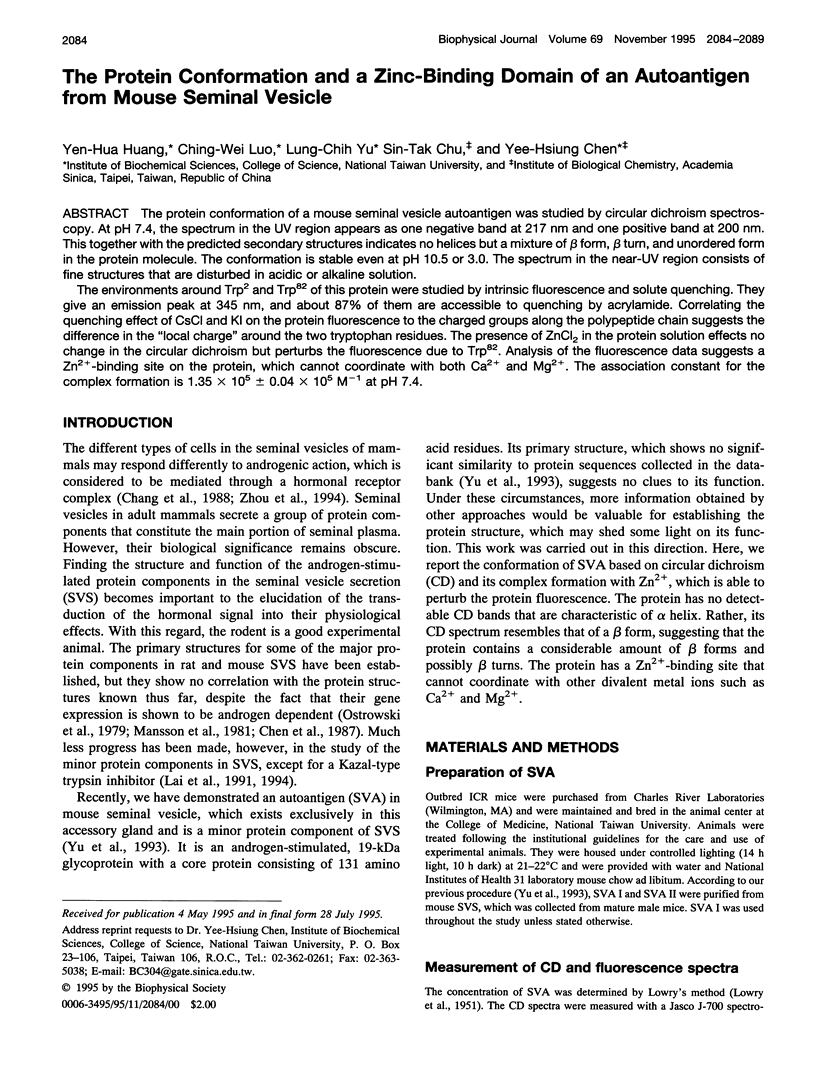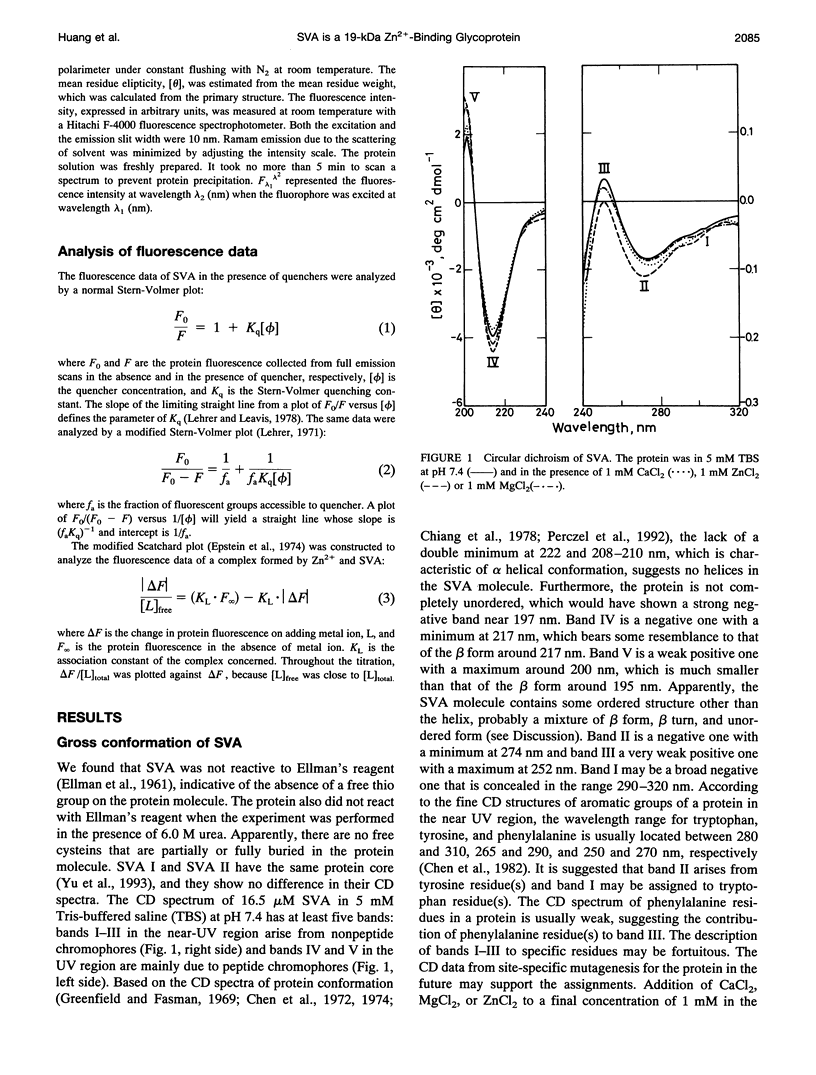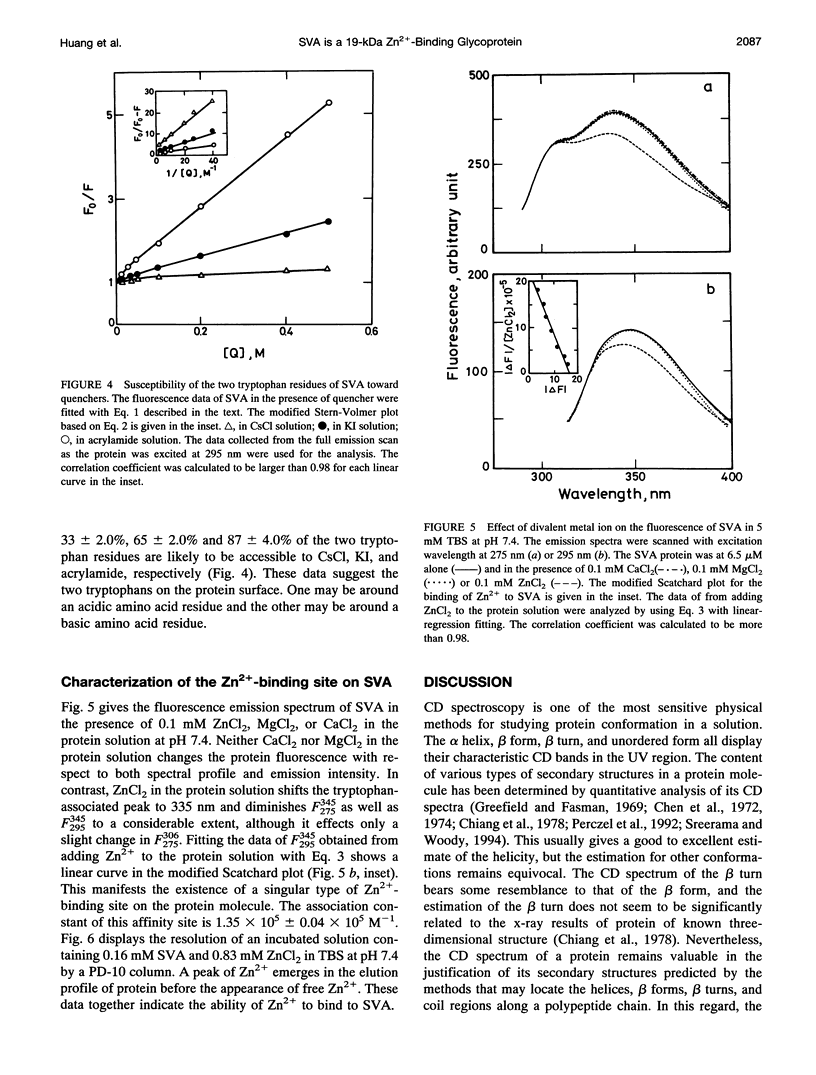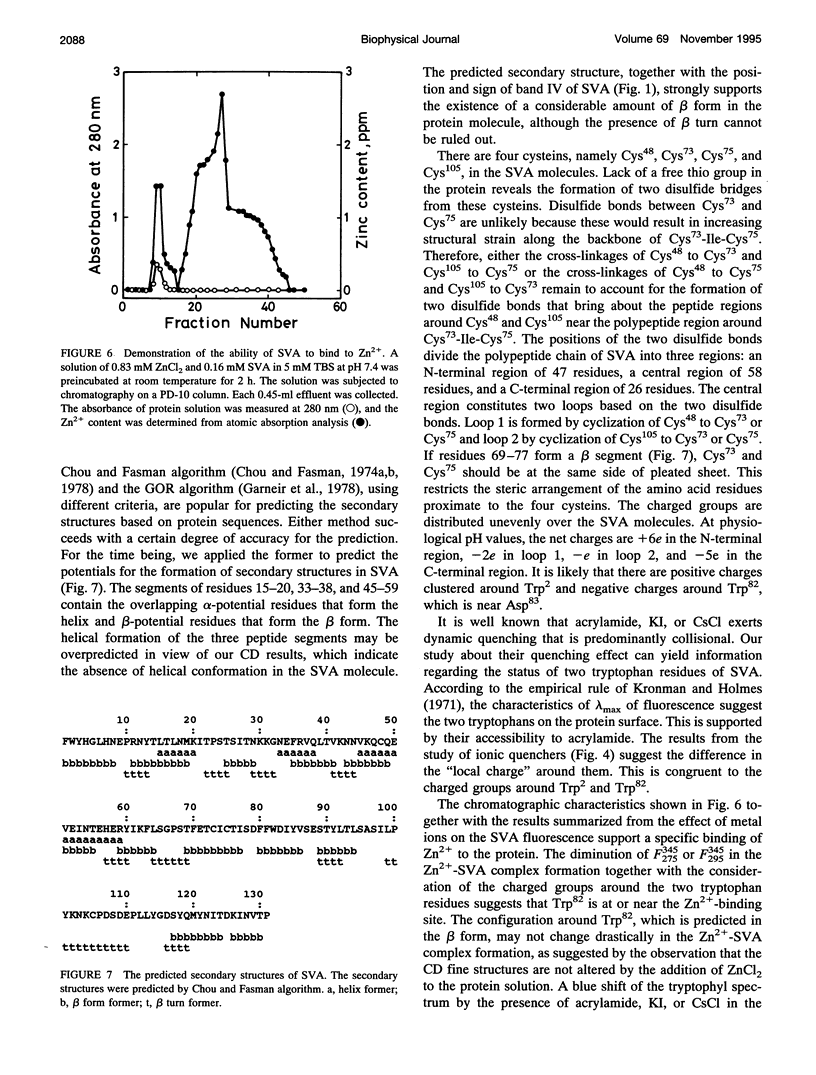Abstract
The protein conformation of a mouse seminal vesicle autoantigen was studied by circular dichroism spectroscopy. At pH 7.4, the spectrum in the UV region appears as one negative band at 217 nm and one positive band at 200 nm. This together with the predicted secondary structures indicates no helices but a mixture of beta form, beta turn, and unordered form in the protein molecule. The conformation is stable even at pH 10.5 or 3.0. The spectrum in the near-UV region consists of fine structures that are disturbed in acidic or alkaline solution. The environments around Trp2 and Trp82 of this protein were studied by intrinsic fluorescence and solute quenching. They give an emission peak at 345 nm, and about 87% of them are accessible to quenching by acrylamide. Correlating the quenching effect of CsCl and Kl on the protein fluorescence to the charged groups along the polypeptide chain suggests the difference in the "local charge" around the two tryptophan residues. The presence of ZnCl2 in the protein solution effects no change in the circular dichroism but perturbs the fluorescence due to Trp82. Analysis of the fluorescence data suggests a Zn(2+)-binding site on the protein, which cannot coordinate with both Ca2+ and Mg2+. The association constant for the complex formation is 1.35 x 10(5) +/- 0.04 x 10(5) M-1 at pH 7.4.
Full text
PDF





Selected References
These references are in PubMed. This may not be the complete list of references from this article.
- Chang C. S., Kokontis J., Liao S. T. Structural analysis of complementary DNA and amino acid sequences of human and rat androgen receptors. Proc Natl Acad Sci U S A. 1988 Oct;85(19):7211–7215. doi: 10.1073/pnas.85.19.7211. [DOI] [PMC free article] [PubMed] [Google Scholar]
- Chang C. T., Wu C. S., Yang J. T. Circular dichroic analysis of protein conformation: inclusion of the beta-turns. Anal Biochem. 1978 Nov;91(1):13–31. doi: 10.1016/0003-2697(78)90812-6. [DOI] [PubMed] [Google Scholar]
- Chen Y. H., Pentecost B. T., McLachlan J. A., Teng C. T. The androgen-dependent mouse seminal vesicle secretory protein IV: characterization and complementary deoxyribonucleic acid cloning. Mol Endocrinol. 1987 Oct;1(10):707–716. doi: 10.1210/mend-1-10-707. [DOI] [PubMed] [Google Scholar]
- Chen Y. H., Tai J. C., Huang W. J., Lai M. Z., Hung M. C., Lai M. D., Yang J. T. Role of aromatic residues in the structure-function relationship of alpha-bungarotoxin. Biochemistry. 1982 May 25;21(11):2592–2600. doi: 10.1021/bi00540a003. [DOI] [PubMed] [Google Scholar]
- Chen Y. H., Yang J. T., Chau K. H. Determination of the helix and beta form of proteins in aqueous solution by circular dichroism. Biochemistry. 1974 Jul 30;13(16):3350–3359. doi: 10.1021/bi00713a027. [DOI] [PubMed] [Google Scholar]
- Chen Y. H., Yang J. T., Martinez H. M. Determination of the secondary structures of proteins by circular dichroism and optical rotatory dispersion. Biochemistry. 1972 Oct 24;11(22):4120–4131. doi: 10.1021/bi00772a015. [DOI] [PubMed] [Google Scholar]
- Chou P. Y., Fasman G. D. Conformational parameters for amino acids in helical, beta-sheet, and random coil regions calculated from proteins. Biochemistry. 1974 Jan 15;13(2):211–222. doi: 10.1021/bi00699a001. [DOI] [PubMed] [Google Scholar]
- Chou P. Y., Fasman G. D. Empirical predictions of protein conformation. Annu Rev Biochem. 1978;47:251–276. doi: 10.1146/annurev.bi.47.070178.001343. [DOI] [PubMed] [Google Scholar]
- Chou P. Y., Fasman G. D. Prediction of protein conformation. Biochemistry. 1974 Jan 15;13(2):222–245. doi: 10.1021/bi00699a002. [DOI] [PubMed] [Google Scholar]
- ELLMAN G. L., COURTNEY K. D., ANDRES V., Jr, FEATHER-STONE R. M. A new and rapid colorimetric determination of acetylcholinesterase activity. Biochem Pharmacol. 1961 Jul;7:88–95. doi: 10.1016/0006-2952(61)90145-9. [DOI] [PubMed] [Google Scholar]
- Epstein M., Levitzki A., Reuben J. Binding of lanthanides and of divalent metal ions to porcine trypsin. Biochemistry. 1974 Apr 9;13(8):1777–1782. doi: 10.1021/bi00705a034. [DOI] [PubMed] [Google Scholar]
- Garnier J., Osguthorpe D. J., Robson B. Analysis of the accuracy and implications of simple methods for predicting the secondary structure of globular proteins. J Mol Biol. 1978 Mar 25;120(1):97–120. doi: 10.1016/0022-2836(78)90297-8. [DOI] [PubMed] [Google Scholar]
- Greenfield N., Fasman G. D. Computed circular dichroism spectra for the evaluation of protein conformation. Biochemistry. 1969 Oct;8(10):4108–4116. doi: 10.1021/bi00838a031. [DOI] [PubMed] [Google Scholar]
- LOWRY O. H., ROSEBROUGH N. J., FARR A. L., RANDALL R. J. Protein measurement with the Folin phenol reagent. J Biol Chem. 1951 Nov;193(1):265–275. [PubMed] [Google Scholar]
- Lai M. L., Chen S. W., Chen Y. H. Purification and characterization of a trypsin inhibitor from mouse seminal vesicle secretion. Arch Biochem Biophys. 1991 Nov 1;290(2):265–271. doi: 10.1016/0003-9861(91)90540-y. [DOI] [PubMed] [Google Scholar]
- Lai M. L., Li S. H., Chen Y. H. Purification and biochemical characterization of a recombinant mouse seminal vesicle trypsin inhibitor produced in Escherichia coli. Protein Expr Purif. 1994 Feb;5(1):22–26. doi: 10.1006/prep.1994.1003. [DOI] [PubMed] [Google Scholar]
- Lehrer S. S., Leavis P. C. Solute quenching of protein fluorescence. Methods Enzymol. 1978;49:222–236. doi: 10.1016/s0076-6879(78)49012-3. [DOI] [PubMed] [Google Scholar]
- Lehrer S. S. Solute perturbation of protein fluorescence. The quenching of the tryptophyl fluorescence of model compounds and of lysozyme by iodide ion. Biochemistry. 1971 Aug 17;10(17):3254–3263. doi: 10.1021/bi00793a015. [DOI] [PubMed] [Google Scholar]
- Mansson P. E., Sugino A., Harris S. E. Use of a cloned double stranded cDNA coding for a major androgen dependent protein in rat seminal vesicle secretion: the effect of testosterone in gene expression. Nucleic Acids Res. 1981 Feb 25;9(4):935–946. doi: 10.1093/nar/9.4.935. [DOI] [PMC free article] [PubMed] [Google Scholar]
- Ostrowski M. C., Kistler M. K., Kistler W. S. Purification and cell-free synthesis of a major protein from rat seminal vesicle secretion. A potential marker for androgen action. J Biol Chem. 1979 Jan 25;254(2):383–390. [PubMed] [Google Scholar]
- Perczel A., Park K., Fasman G. D. Analysis of the circular dichroism spectrum of proteins using the convex constraint algorithm: a practical guide. Anal Biochem. 1992 May 15;203(1):83–93. doi: 10.1016/0003-2697(92)90046-a. [DOI] [PubMed] [Google Scholar]
- Sreerama N., Woody R. W. Poly(pro)II helices in globular proteins: identification and circular dichroic analysis. Biochemistry. 1994 Aug 23;33(33):10022–10025. doi: 10.1021/bi00199a028. [DOI] [PubMed] [Google Scholar]
- Vallee B. L., Falchuk K. H. The biochemical basis of zinc physiology. Physiol Rev. 1993 Jan;73(1):79–118. doi: 10.1152/physrev.1993.73.1.79. [DOI] [PubMed] [Google Scholar]
- Yu L. C., Chen J. L., Tsai W. B., Chen Y. H. Primary structure and characterization of an androgen-stimulated autoantigen purified from mouse seminal-vesicle secretion. Biochem J. 1993 Dec 15;296(Pt 3):571–576. doi: 10.1042/bj2960571. [DOI] [PMC free article] [PubMed] [Google Scholar]
- Zhou Z. X., Wong C. I., Sar M., Wilson E. M. The androgen receptor: an overview. Recent Prog Horm Res. 1994;49:249–274. doi: 10.1016/b978-0-12-571149-4.50017-9. [DOI] [PubMed] [Google Scholar]


